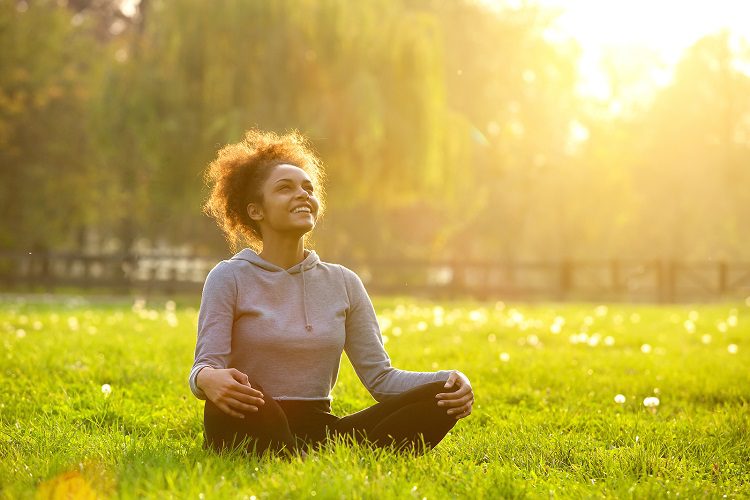While you’ve heard of mindful meditation, in which you slow down your thoughts and channel your mind’s focus, this isn’t the only way to practice a more mindful way of being.
There are many mindfulness exercises you can do throughout your day to help you connect with your truth and foster a state of calm.
How does mindfulness help you? Mindfulness has many benefits, such as greater self-observation, enhanced intuition, greater focus and memory, and stress relief.
With that in mind, let’s explore 10 of the best mindfulness exercises. We’ll feature how to do them and show you what you stand to gain from giving them your full attention.
Best Mindfulness Exercises And How They Benefit You
Walking Meditation

This is a beneficial mindfulness exercise because it enables you to get out into nature. Studies have shown that people who spend two hours per week walking in nature report good health and psychological wellbeing.
How this exercise works is that you walk very slowly so that you can concentrate on your walking. Pay attention to the sensations in your body, such as when you take a step and how you maintain your balance.
When you do mindful walking, you’ll be aware of every step and breath you take. This helps you to release your worries and stresses while encouraging a state of peaceful wellbeing.
Even if you can’t get out into nature, walking meditation can be done through busy roads of the city or through a supermarket parking lot, so it’s practical.
Mindful Seeing
This is an easy exercise you can do whenever you’re outside or have a view of what’s outside from the window.
Look at everything you can see, but instead of labelling objects in your mind, such as “house,” or “stop sign,” it’s better to pay attention to things like patterns, textures, and colors, such as how the light streams onto the leaves of a tree or the beautiful colors of the neighbor’s cat.
Imagine that you’re seeing the sights for the first time as this will make you notice more details about them. If you find that your thoughts distract you, gently coax them back to the sights and what you can see.
This is a great exercise that’s useful to do if you’re beginning with mindful meditation. Instead of having to imagine things in your mind, which isn’t always easy for everyone to do, you can simply look at things around you and use them for mindfulness.
Five Senses

This is a mindfulness exercise you can use whenever you need to get into a mindful state of mind. It engages your five senses.
Start by noticing five things you can see. These can be obvious things, such as birds in a tree, or less obvious things, like a crack in the pavement or a puddle on the side of the road.
Notice four things you can feel. These can include things like the comfortable bed on which you’re sitting, the sun on your skin, the fresh breeze on your face, or the smoothness of your steering wheel.
Notice three things that you can hear. Listen for sounds in your environment. You’ll be surprised at how many you tune out of because your mind is concentrating on other things!
Examples of things you might hear are birdsong, traffic sounds, the sound of your breathing, or the sound of co-workers typing on their computers.
Notice two things you can smell. These can be the smell of your perfume, the smell of food cooking, or even the smell of car pollution.
Notice one thing you can taste. This might be a difficult one to do if you’re not eating or drinking anything, but you could just focus on the current taste in your mouth.
Three-Minute Mindful Breathing
If you have a busy lifestyle in which you don’t have much time for mindful meditation, but you want to reap the benefits of breathing meditations, this three-minute breathing session can help you.
- For the first minute: Answer the question, “How am I doing right now?” Allow your thoughts and feelings to the surface. Find words or phrases for them.
- For the second minute: Be aware of your breathing for the whole minute.
- For the third minute: Focus on how your breathing affects the rest of your body. For example, feel it moving into your lungs and then out of them again. As you take deep breaths, feel how it relaxes your muscles and slows down your heart rate.
If, at any time during this session, you feel that it’s difficult not to let other thoughts pop into your mind, gently allow them to appear in your mind and then watch them disappear, like clouds across a sky.
The point is just to watch them without trying to control them.
Mindful Eating

Do you ever find that you rush through eating, or is eating usually a social event that’s filled with chatter and laughter so you don’t even pay attention to your food?
Being more mindful about how you eat can help you to improve your digestion because you eat slower, while also encouraging you to appreciate the eating experience.
- Pay attention to the food on your plate or in your hand. Notice how it feels if you’re holding it, and notice its weight, color, and texture. Smell it.
- When you start eating the food, do so at a slow pace. Focus your mind on the food. Notice how it tastes and feels in your mouth.
Unpleasant Emotion Mindfulness
We all experience unpleasant emotions from time to time, such as anger. Knowing how to deal with those feelings instead of allowing them to negatively impact us or cause us to change, such as by allowing the anger to make us bitter, is useful for anyone to master.
While the below exercise specifically targets anger, you can use it for any unpleasant emotion.
- Find a comfortable place to sit, whether on the floor or a chair.
- Close your eyes and take in a few deep breaths.
- Think about a recent or current event in your life when you experienced the unpleasant emotion you are dealing with, such as anger.
- Give yourself permission to feel that emotion.
- Focus your attention solely on that emotion. If other emotions try to surface, such as sadness, gently coax them away so you can concentrate on the anger.
- Pay attention to how the anger feels in your body. For example, maybe you feel warmth in your face, you can feel your heart rate increase, and so on. You should also notice if the emotion changes as you focus on it or it moves through your body.
- Once you’ve done that, let compassion enter the picture by being gentle with the unpleasant emotion. Think about it as a young child who has done something wrong but who you love. Be understanding and loving towards it.
- Let the emotion go. Focus your attention on your breathing until the emotion fades away.
Afterwards, take some time to reflect on what happened during the mindfulness exercise. Think about the sensations you experienced and if they changed throughout the session.
Waking Mindfulness

This exercise should be done when you wake up in the morning.
- Find a comfortable spot where you can sit in a relaxed way, but keep your spine straight.
- Close your eyes and think about the sensations you can feel in your body.
- Take three deep breaths. Breathe in through your nose and exhale out your mouth.
- Allow your breath to get into its own rhythm and observe it without trying to control it.
- Ask yourself what your intention is for the day. This can help you to prepare for the upcoming day and think about what you want to achieve.
- Some other useful questions you could ask yourself include, “What do I need to take care of myself today?” or “How can I feel more fulfilled throughout my day?”
- Think about the answers to these questions, and then decide on what your intention is for the day. For example, “Today I will look after myself and be kind to myself,” or “Today I will stay grounded.”
Single-Task Mindfulness
You might be used to multi-tasking but it’s not always productive.
Studies have found that when our mind jumps around between tasks, we are less efficient and more likely to make errors, especially if the tasks are complex and require a lot of focus.
Free up your focus by engaging in single-task mindfulness. Concentrate on one task that you’re doing, and then follow these steps during the activity.
- Focus on how you’re breathing. Don’t try to control how you’re breathing. Just be aware of it.
- Focus on how your body feels, such as how you feel while sitting in your chair or how you feel while standing.
- Feel the sensation of the air or your clothes against your skin. If you’re outside, you could also focus on the feeling of the breeze and sun on your skin.
- Pay attention to the posture of your body.
The above steps bring your attention to your task while preventing you from being distracted by other thoughts. They can also help you to deal with stress.
Box Breathing
This is another mindfulness exercise you can do wherever you are and it focuses on your breathing so that you can cultivate a calmer, more peaceful attitude.
The reason why it’s called “box breathing” is because you breathe for certain counts while visualizing a box in your mind. Here’s how to do it.
- Start by inhaling to the count of four. While you do this, visualize the top edge of a box.
- Hold your breath for four counts, and visualize going down along the right side of the box.
- Exhale for a count of four, while visualizing that you’re moving from the right to the left along the bottom of the box.
- Hold your breath for another count of four, while visualizing your eyes moving along the left side of the box and then back to the top.
- Repeat this a few times for at least a minute.
Tip: If you battle to imagine the box in your mind while you do this exercise, it can be useful to first read through the exercise’s steps to familiarize yourself with how to do it.
Pause At The Door

This is an exercise you’ll like because it’s quite different from the others we’ve featured so far. This is a mindfulness habit that can help you to be more aware as you move through your day.
How it works is that whenever you walk through a door, such as by stepping into a room in the house or walking through your front door, you should pause for a second and take a breath.
Pay attention to the differences you feel in every space you enter.
Related Questions
What are the three main characteristics of mindfulness?
The three mindfulness characteristics are attention to cultivating awareness, attention to what’s happening in the present moment, and a non-judgmental attitude that is also kind.
How can mindfulness improve your relationships?
Many of our responses and behaviors are habitual, so shifting them into more positive ones can benefit our relationships.
Mindfulness can help us become aware of our habits, such as during communication, and improve them.
Conclusion
If you want to be more mindful, you can dedicate time to mindful meditation but you can also do mindfulness exercises.
In this article, we’ve looked at 10 of the best mindfulness exercises, why they’re useful, and how they can help you to become more aware.
Resources:










